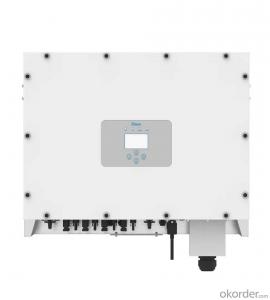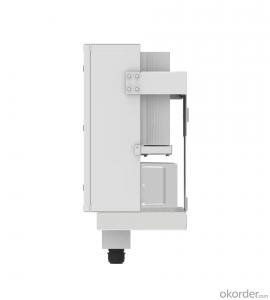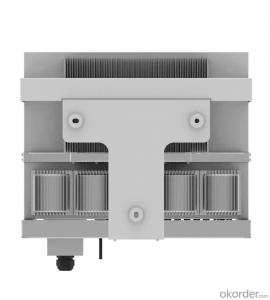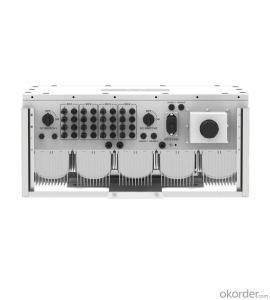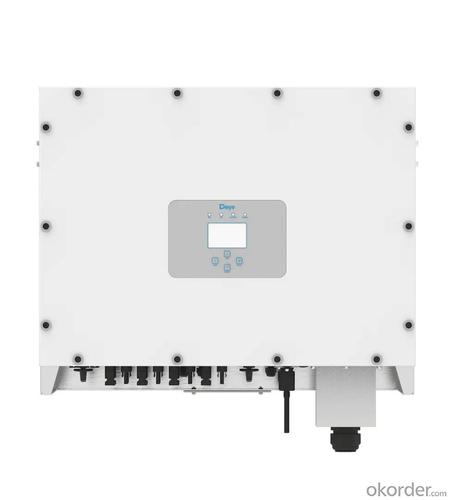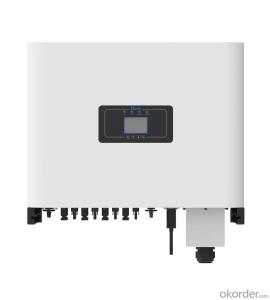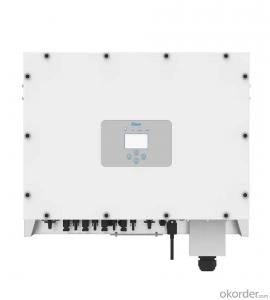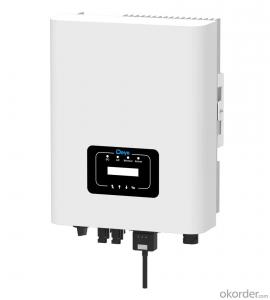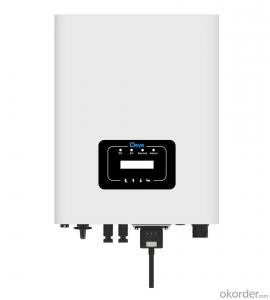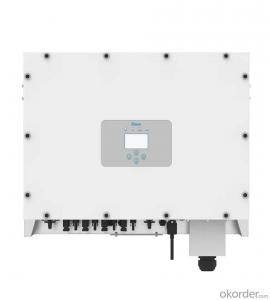SPS Solar Inverter - Sun-60/70/75/80k-G | 60-80kW | Three Phase | 4 MPPT
- Loading Port:
- Ningbo
- Payment Terms:
- TT OR LC
- Min Order Qty:
- 100 pc
- Supply Capability:
- 5000 pc/month
OKorder Service Pledge
OKorder Financial Service
You Might Also Like
Specification
| Model | SUN-60K-G | SUN-70K-G | SUN-75K-G | SUN-80K-G | ||
| Input Side | ||||||
| Max. DC Input Power (kW) | 78 | 91 | 97.5 | 104 | ||
| Max. DC Input Voltage (V) | 1000 | |||||
| Start-up DC Input Voltage (V) | 250 | |||||
| MPPT Operating Range (V) | 200~850 | |||||
| Max. DC Input Current (A) | 40+40+40+40 | |||||
| Max. Short Circuit Current (A) | 60+60+60+60 | |||||
| Number of MPPT / Strings per MPPT | 4/3 | 4/4 | 4/4 | 4/4 | ||
| Output Side | ||||||
| Rated Output Power (kW) | 60 | 70 | 75 | 80 | ||
| Max. Active Power (kW) | 66 | 77 | 82.5 | 88 | ||
| Nominal Output Voltage / Range (V) | 3L/N/PE 380V/0.85Un-1.1Un, 400V/0.85Un-1.1Un | |||||
| Rated Grid Frequency (Hz) | 50 / 60 (Optional) | |||||
| Operating Phase | Three phase | |||||
| Rated AC Grid Output Current (A) | 87 | 101.5 | 108.7 | 115.9 | ||
| Max. AC Output Current (A) | 95.7 | 111.6 | 119.6 | 127.5 | ||
| Output Power Factor | ||||||
| Grid Current THD | <3%< td=""> | |||||
| DC Injection Current (mA) | <0.5%< td=""> | |||||
| Grid Frequency Range | 47~52 or 57~62 (Optional) | |||||
| Efficiency | ||||||
| Max. Efficiency | 98.7% | |||||
| Euro Efficiency | 98.3% | |||||
| MPPT Efficiency | >99% | |||||
| Protection | ||||||
| DC Reverse-Polarity Protection | Yes | |||||
| AC Short Circuit Protection | Yes | |||||
| AC Output Overcurrent Protection | Yes | |||||
| Output Overvoltage Protection | Yes | |||||
| Insulation Resistance Protection | Yes | |||||
| Ground Fault Monitoring | Yes | |||||
| Anti-islanding Protection | Yes | |||||
| Temperature Protection | Yes | |||||
| Integrated DC Switch | Yes | |||||
| Remote software upload | Yes | |||||
| Remote change of operating parameters | Yes | |||||
| Surge protection | DC Type II / AC Type II | |||||
| General Data | ||||||
| Size (mm) | 700W×575H×297D | |||||
| Weight (kg) | 60 | |||||
| Topology | Transformerless | |||||
| Internal Consumption | <1W (Night) | |||||
| Running Temperature | -25~65℃, >45℃ derating | |||||
| Ingress Protection | IP65 | |||||
| Noise Emission (Typical) | <55 dB | |||||
| Cooling Concept | Smart cooling | |||||
| Max. Operating Altitude Without Derating | 2000m | |||||
| Warranty | 5 years | |||||
| Grid Connection Standard | CEI 0-21, VDE-AR-N 4105, NRS 097, IEC 62116, IEC 61727, G99, G98, VDE 0126-1-1, RD 1699, C10-11 | |||||
| Operating Surroundings Humidity | 0-100% | |||||
| Safety EMC / Standard | IEC/EN 61000-6-1/2/3/4, IEC/EN 62109-1, IEC/EN 62109-2 | |||||
| Features | ||||||
| DC Connection | MC-4 mateable | |||||
| AC Connection | IP65 rated plug | |||||
| Display | LCD 240 × 160 | |||||
| Interface | RS485/RS232/Wifi/LAN | |||||
The Deye 60-80K grid-connected inverter is suited for medium and large-scale commercial rooftops and ground-mounted solar PV system in which reliability and stability are important. the full series inverter has 30% DC input oversizing ratio and 10% AC output overloading ratio, offering a faster return on investment.
4 MPP tracker, Max. efficiency up to 98.7%
Zero export application, VSG application
String intelligent monitoring (optional)
Wide output voltage range
Type II DC/AC SPD
Anti-PID function (Optional)
- Q: How do you choose the right output voltage for a solar inverter?
- When choosing the right output voltage for a solar inverter, several factors need to be considered. These include the electrical requirements of the appliances or devices that will be powered by the inverter, the maximum power capacity of the solar panels, and the efficiency of the inverter itself. It is important to select an output voltage that matches the voltage requirements of the appliances while ensuring that the inverter can handle the power load efficiently. Additionally, considering the compatibility of the inverter with the solar panel system and any battery storage can also influence the choice of the right output voltage.
- Q: How does a solar inverter handle temperature variations?
- A solar inverter is designed to handle temperature variations by incorporating advanced thermal management systems. These systems ensure that the inverter operates within a specified temperature range, typically between -25 to 60 degrees Celsius. The inverter uses internal fans, heat sinks, and sometimes liquid cooling mechanisms to dissipate heat generated during operation. Additionally, the inverter may have temperature sensors that monitor the internal and external temperatures, allowing it to adjust its performance and efficiency accordingly. This temperature management enables the solar inverter to operate optimally and maintain its reliability even in extreme temperature conditions.
- Q: Grid-connected inverter is generally divided into photovoltaic power generation grid-connected inverter, wind power grid-connected inverter, power equipment and grid-connected inverter and other power generation equipment power generation inverter.
- The small use of field-effect transistors while using a DSP conversion controller to improve the quality of the output power makes it very close to the sine wave current.
- Q: How does a solar inverter handle voltage and frequency variations caused by grid disturbances?
- A solar inverter is designed to handle voltage and frequency variations caused by grid disturbances by employing various control mechanisms and protection features. Firstly, the inverter continuously monitors the voltage and frequency levels of the grid, and it adjusts its output accordingly to match the grid's requirements. If there is a voltage or frequency fluctuation, the inverter will either increase or decrease the output power to maintain the desired voltage and frequency levels. To handle voltage variations, the solar inverter utilizes a voltage regulation mechanism. If the grid voltage increases or decreases beyond a certain threshold, the inverter adjusts its internal voltage regulation circuitry to ensure a stable and regulated output voltage. This helps protect the inverter and connected devices from potential damage due to overvoltage or undervoltage conditions. Similarly, to handle frequency variations, the solar inverter incorporates a frequency control mechanism. If the grid frequency deviates from the specified range, the inverter adjusts its internal frequency control circuitry to maintain a stable and accurate output frequency. This ensures that the power generated by the solar panels remains synchronized with the grid, allowing for efficient power transfer and preventing any damage to the inverter or connected devices. Furthermore, solar inverters often include advanced features such as anti-islanding protection. This feature detects any abnormal grid conditions, such as voltage or frequency fluctuations beyond a safe limit. If an islanding condition is detected, where the solar system continues to generate power even when the grid is down, the inverter will disconnect from the grid to prevent any potential safety hazards for utility workers. Overall, a solar inverter is designed to handle voltage and frequency variations caused by grid disturbances through continuous monitoring, voltage regulation, frequency control, and protective features. These capabilities ensure reliable and safe operation of the solar power system while maintaining a stable connection with the utility grid.
- Q: What is the role of a solar inverter in reactive power compensation during grid disturbances?
- The role of a solar inverter in reactive power compensation during grid disturbances is to regulate and stabilize the flow of reactive power between the solar PV system and the grid. During grid disturbances, such as voltage fluctuations or power factor variations, the solar inverter can actively inject or absorb reactive power to maintain the voltage and power factor within acceptable limits. This helps in improving the overall stability and reliability of the grid system, ensuring efficient power transfer, and minimizing any adverse effects on the grid and connected electrical devices.
- Q: What are the key factors affecting the efficiency of a solar inverter?
- The key factors affecting the efficiency of a solar inverter include the quality and design of the components used, the temperature at which the inverter operates, the type and condition of the solar panels connected to it, the efficiency of the conversion process from DC to AC power, and the overall system design and installation.
- Q: What are the key factors affecting the compatibility of a solar inverter with other system components?
- The key factors affecting the compatibility of a solar inverter with other system components include the voltage and frequency requirements of the inverter, the capacity and type of the solar panels being used, the type and capacity of the battery storage system, and the overall electrical load of the system. Additionally, the communication protocols and interfaces supported by the inverter and other components play a crucial role in ensuring compatibility and seamless integration within the system.
- Q: What is the role of a power control unit in a solar inverter?
- The role of a power control unit in a solar inverter is to regulate and control the flow of electricity between the solar panels and the grid. It ensures maximum power output from the solar panels by optimizing their performance and matching it with the electrical requirements of the grid. Additionally, it provides protection against overvoltage, overcurrent, and other electrical faults to ensure safe and efficient operation of the solar inverter system.
- Q: How does a solar inverter handle voltage fluctuations during grid disturbances?
- A solar inverter handles voltage fluctuations during grid disturbances by continuously monitoring the grid voltage. When it detects a fluctuation or disturbance, it adjusts its own output voltage to match the grid's voltage. This ensures that the solar inverter remains synchronized with the grid and delivers stable electricity without causing any damage to the connected appliances or the grid itself.
- Q: Can a solar inverter be used with solar-powered data centers?
- Yes, a solar inverter can be used with solar-powered data centers. A solar inverter converts the direct current (DC) produced by solar panels into alternating current (AC) that can be used to power electrical equipment, including data centers. By connecting the solar panels to a solar inverter, the generated solar energy can be effectively utilized to power data centers, making them more sustainable and reducing reliance on traditional power sources.
Send your message to us
SPS Solar Inverter - Sun-60/70/75/80k-G | 60-80kW | Three Phase | 4 MPPT
- Loading Port:
- Ningbo
- Payment Terms:
- TT OR LC
- Min Order Qty:
- 100 pc
- Supply Capability:
- 5000 pc/month
OKorder Service Pledge
OKorder Financial Service
Similar products
Hot products
Hot Searches
Related keywords
